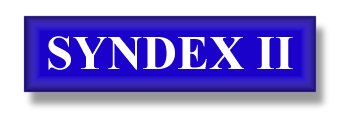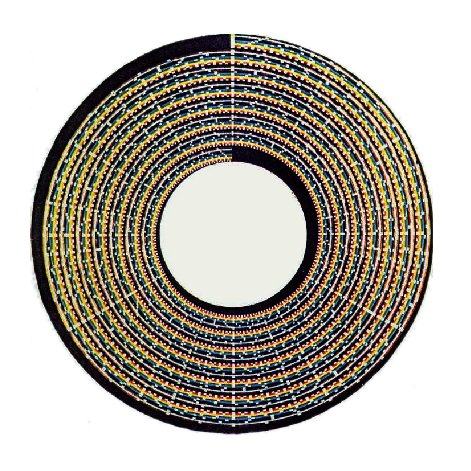



 THE
AURIC KEY
THE
AURIC KEY
By Iona Miller, c1999
"Your cyclic synchrographing work clarifies and simplifies this whole matter to an epochal degree. At any rate, your work fills me with joy. Would you be willing to have me publish this work in another edition of SYNERGETICS with full credit to you?"
Buckminster Fuller to Bob Marshall, 1981
"...the powers of human reason could not be limited to any accepted prearranged system of formalized rules. What Godel showed was how to transcend any such system of rules, as long as those rules themselves could be trusted."
Roger Penrose
"Mandalogs 2520 and 108"

"Bob and Iona's Adventures
in SUM AREA"
Classical cultures are characterized by certain basic ideas, of which metrology is foremost. Ancient metrology was a system of interlinked measures, numeration, astronomical cycles, and geodetic standards. We can find the most often cited numbers of ancient metrology extrapolating out of a certain numerical sequence, (The Holotomic Sequence).
We begin with the question of why some unknown and ancient geometer selected 360 degrees for dividing the celestial sphere and the circle. The division of 360 by 12 produced one of the first historical cosmologies--the Zodiac. The basis of this standard of circular unity can be deduced.
360 is divisible by all eight base digits except the number 7. To include 7 as a divisor, the prime circular module must be raised to 2520, the Auric Key, the lowest number divisible by all base digits. From this clue, we can destrapolate and extrapolate an essential sequence, a family of numbers.
It turns out that 360 is but one in a strategic series of circular unities based on prime number multiplexing. Numbers 2, 3, 5, 7, 11, and 13 are the first primes. By starting with 6 (the first perfect number) and multiplying by the primes in their natural order, we get the sequence 12, 24, 72, 360, 2520, 27720, 360360, 6126120, etc. Each of these numbers forms a geometrical entity, a circular unity, (Holotome). These numbers just happen to be the exact sequence of minimal sums that accomodate the maximal amount of factors of division. Their synergetic qualities have remained unnoticed in classical number theory.
This minimalism is reflected in Syndex number theory. The first concern of Syndex method is to encode the maximum information expressed through minimal graphic elements. Therefore, we employ correspondences between numbers, colors, and frequencies of divisibility to integrate the system.
The number 2520 is the Auric Key. It, not 360, is the first number divisible by all nine base digits. It is exactly twice the number 1260, a number referred to cabalistically five times in the Book of Revelations (12:6 and 12:4). It is half of the number 5040, which figures prominently in Plato’s “Laws” regarding his ideal city/state.
This number 2520, more than 360, captures nature’s cyclic behaviors. And the graphic number wheel (synchrograph or mandalog) based on this number reverses to form a mirror image of itself at the midpoint of 1260. The real key involves the sequence in which prime numbers naturally occur in the base-10 continuum.
This synergetic effect is demonstrated by multiplying the third and fourth Holotomes together: 72 x 360 = 25920, a number given for the Precession of the Equinoxes in Sumerian cuneiform records. In Sumeria, mathematics was based on a sexagesimal system (60s) with a decimal substrate (10s). The Sumerian sar was based on multiples of 36, 360, 3600; it was known as the number of the Universe (36 x 10 = 360). Imagine a circle for space of 360 degrees x 60 minutes x 60 seconds = 1,296,000 seconds.
The real key to this system involves the sequence in which prime numbers naturally occur in the base-10 continuum:
72 x 360 = 25920 divided by 2 = 12960; divided by 3 = 8640; divided by 4 = 6480; divided by 6 = 4320. 72 + 360 = 432.
The precessional number, 25920, can also be arrived at by 432 x 60 = 25920, employing the Sumerian sexagesimal system. This number relates directly to ancient Hindu cosmology and divine time measurement as the Ages and Yugas. Their numbers (without the cosmological zeros) include 432, 864, 1296, 1728, 4320 for the Yugas, and 648, 1296, 1944, 2592, 6480 for the Ages. Both Ages and Yugas share the number 1296 (362).
The Hindu systems are based on multiples of #108 (3 x 36), the divine numberword OM, also known as the number of the Universe. The Yugas and Ages can also be generated on multiples of 36. Multiply by 12, 24, 36, and 48 for the Yugas; and 18, 36, 54, and 72 for the Ages.
12960 (half the Precessional cycle) is a numerical basis for astronomical measures and played a role in Plato's mystic symbolism: 12 x 2160 (Platonic Month) = 25920 (Platonic Year). In all cases, the historical precedent for this system comes from Sumeria, and its ancient cosmology inspired by horizon-based astronomy. These numbers and their importance come from direct observation of the precessional cycle and orbital times of the planets.
Ancient India raised mathematics and astronomy to a fine art. In medieval times, it gave the west its system of so-called Arabic numerals, the base-10 system, place value, and the zero, and created a Renaissance in art and science. It is within this system of mathematical notation that the +4, -4 basewave inherent in the continuum can most easily be seen through the mechanism of palindromes and transpalindromes.
SYNDEX I identifies and demonstrates the various properties of the base-10 number field, such as the symmetrical distribution of prime numbers. The continuum can be viewed as both progressive and regressive, or self-reflexive. The key to the comprehensive analysis of general number behavior is found in the concept of "circular unity." The graphic importance of the Holotomic Sequence is that circular symmetry is being conserved and may be enlisted as the fundamental reference key in the graphic investigations of number behavior. The primes are deployed in symmetrical interface only within these specific Holotomic domains.
Synchrographics regards symmetry as a primary analytical reference, making the Syndex archetypal system of number classes possible. The foundation of this system is palindromes and transpalindromes, yielding 12 classes of number. Palindromes, or binomial reflection numbers are neither purely accidental nor without significance. Transpalindromes are the reversal of any particular number exceeding a single digit.
Numeronomy, the laws relating to the essential structure and dynamics of number, is a new word for an extremely ancient science. This science, (based on the knowledge that the continuum contains a definite structural order with general laws that describe the nature of that order), has laws that relate to the general behavior of nature itself. Each number has both a geometrical and numerical identity. The outcome of Synchrographics is that numbers speak for themselves through structure and synergetic behavior.
All Syndex mandalogs (number wheels) are the product of the systematic generation of the exact sequence of minimax factorization. They have the perfect retrograde feature by which the patterns generated in the first half of the spiral are reversed at midpoint and are reflected as a mirrored image in the second half of the spiral. Revisioning the number continuum with the concept of simultaneous counterflow yields a more accurate picture. This revisioning is also happening in post-quantum physics under the rubric of quantum backflow.
With large spans of numbers, the complex interrelationships become difficult to visualize without good graphics. Because of the octave nature of the base cycle, there cannot be more than four consecutive transpalindromic pairs in a single symmetrical sequence, regardless of the amount of digits in each individual number. The Holotomic Sequence consists of a series of key numbers or circular unities in the rhythmic wave.
Buckminster Fuller was very excited and "filled with joy" over these revelations, when the Syndex discoveries were shared with him before his death. He wanted to publish them in a subsequent edition of Synergetics. And why not, since they shed light on old enigmas. After all, numbers are what they are, not what we wish them to be. They will not do what they cannot do, i.e. show symmetries where none exist.
[Mandalog #108/OM]SYNDEX II is about the process of discovering synergetic, rhythmic symmetries on a graphic enspiralment called Synchrograph C. It is based on the Hindu number of the Universe, 108. On this number wheel, the natural numbers are spiralled 60 times around a radial array of 108 increments to the number 6480. Contemplating the C-Graph over the years has produced several revelations, including the Holotomic Sequence, created by prime number multiplexing, and the exemplary 9/11 wave cycle (a +4, -4 base wave).
On Synchrograph C all the numbers that represent the two Hindu astrocalendaric systems fall in the same zero axis. The sum of the Yugas falls at 2/3 of this axis. 6480 divided by 3 = 2160, the Platonic Month; 12 x 2160 = 25920, Platonic Year. On this graph the four-digit palindromic sequence (1881, 2772, 3663, 4554) appears in quadratic array, where only chaos exists in classical number theory.
Jung asserted that number forms the particular element which unites the realms of psyche and matter. It is real in an archetypal, qualitative sense and a quantitative sense, uniting the imaginal and the physically knowable. The psychic dynamics of the concept of number appear archetypally as its "transgressive" aspect in the realm of matter. Numbers above the threshold of consciousness appear as quantitative discontinuities and qualitative individual numbers. But according to the Jungians, in the unconscious they interpermeate and overlap participating in the one continuum that runs through them all.
Thus, we find certain synchronicities in the Syndex numberwheel mandalas, creating metaphysical and empirical harmonies. Certain authentic mathematical structures can originate in the unconscious even though Western number theory has traditionally followed a very different path, using its accepted, formalized rules. On rare occasions graphical architecture combines with the data content to yield a uniquely spectacular graphic. Such entities caqn be described and admired but there are no compositional principles on how to create that one wonderful graphic in a million.
The ultimate Platonic ideal was that of Beauty. The most beautiful graphics do not traffic with the trivial. Graphical elegance is often found in simplicity of design and complexity of data. Visually attractive graphics also gather their power for content and interpretations beyond the immediate display of some numbers. The best graphics are about the useful and important, about life and death, about the universe.
* * *
Click here to go to SYNDEX I: contains more on Synergetics and Qabala, magick, Stonehenge, ancient insight.
The Diamond Body: Buckminster Fuller and the Qabala; N = 50, V = 6; Music of the Spheres; Number and Jung's Transformational Process; The Auric Key; Numeronomy and Synchrographics.
Click here to go to SYNDEX II: number mysticism and alphanumeric writing; cosmic cycles of creation and destruction (Yugas and Ages); ancient Hindu mathematics & astronomy; mandalog #108; the Sumerian legacy; models of sacred space; milestones in the evolution of the number concept; Syndex number theory; metrology; cosmography.
Click here for the next article in SYNERGETIC QABALA, Virtual Therapy & Magic; Dream Guide.
Click here to continue with Syndex I. 
Robert Marshall, Master Numeronomist
Iona Miller
Click here to go to Iona Miller's Home PageUnder Synergetic Construction...
Created 7/10/99
Last Updated 01/01/00Web Design By Vickie Webb